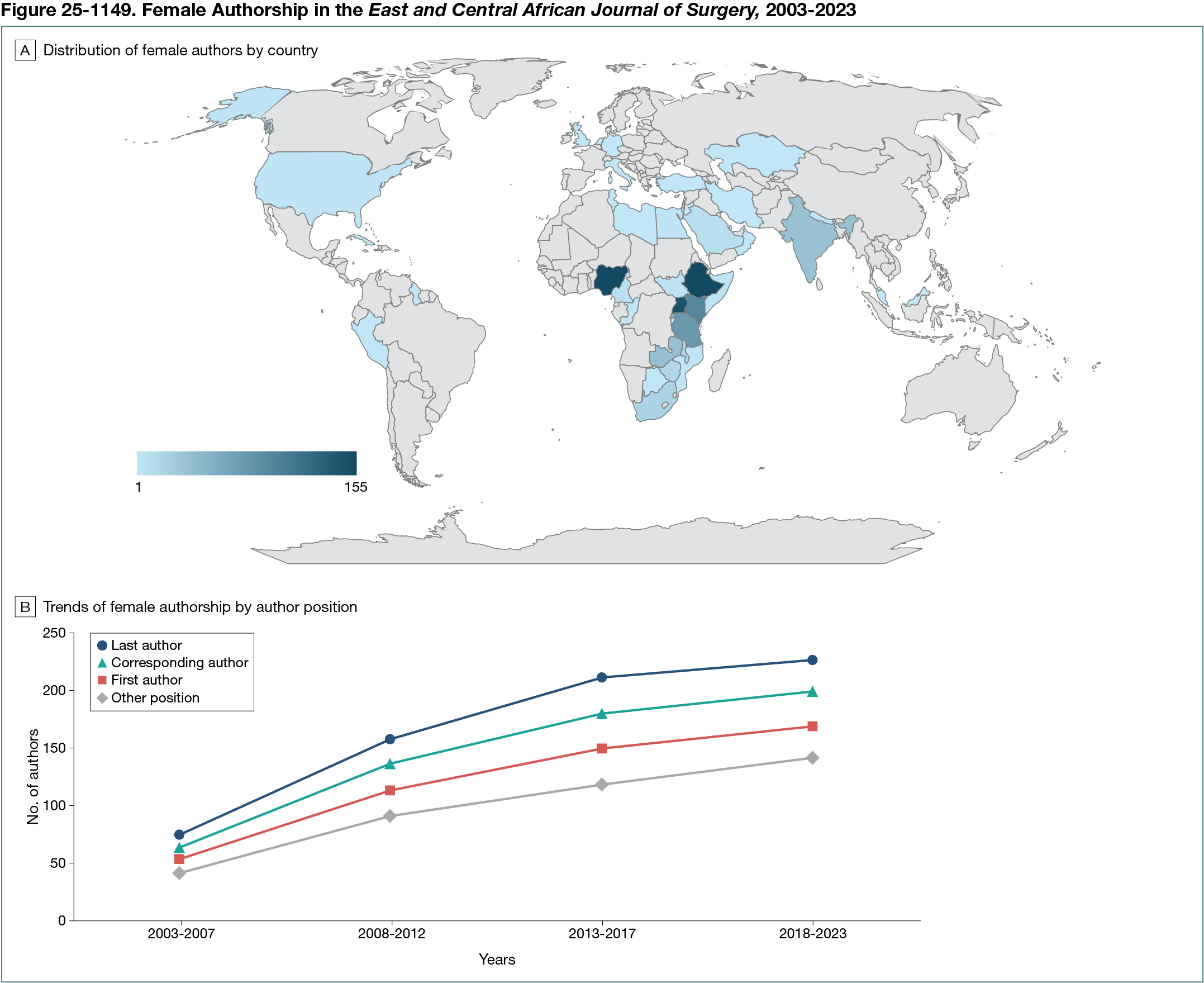Abstract
Evolution of Authorship Diversity in African Surgical Research Over 2 Decades
Vincent Kipkorir,1 Godfrey Sama,1 Mumba Chalwe,1 Tihitena Negussie,1 Michael Mwachiro,1 Robert Parker,1 Seke Kazuma,1 Stella Itungu,1 Abebe Bekele1
Objective
Underrepresentation along geographical and gender lines has historically been observed in academic surgery.1 However, efforts have been made in recent years to ensure equity and inclusion in the surgical learning environment to increase female representation and ensure geographically diversified research engagements.2 We set out to explore the evolution of authorship diversity in African surgical research using publications featured in an African surgical journal.
Design
This was a retrospective cross-sectional study. Data were collected from all articles published in the East and Central African Journal of Surgery between 2003 and 2023. Article metadata and author biodata were extracted from each article for subsequent analysis. Author gender was established by 2 independent reviewers through an online search, confirmed by a minimum of 2 web pages including LinkedIn, editorial profiles, institutional websites, and ResearchGate. For original articles, case series, and case reports, geographical location was determined by the primary study site. For the other articles, we used the author’s institutional affiliation.
Results
A total of 889 articles were included featuring 3001 authors; 2609 (86.9%) were male and 392 (13.1%) were female. In total, 92 females (3.1%) were designated as first authors, 93 (3.1%) as corresponding authors, and 90 (3.0%) as last authors. There was a predominance of males in the positions of first, last, and corresponding author. Despite this, the number of females represented in these categories had a steady increase over the years. The gender disparity ratio increased in the first 15 years, then dropped in the last 5 years. There were 2523 African authors (84.1%), with Ethiopia having the largest number of authors (155 [5.2%]). The distribution according to country and the trends in female authorship are presented in Figure 25-1149.
Conclusions
Our findings show disparities in the ratio of male to female authors, with a substantial male predominance. While it is encouraging to note the steady increase in the number of female authors over the years, a wide gap remains. The steady rise may be attributed to the overall rise in female surgeons following the recent establishment of women in surgery associations and better advocacy and funding toward empowerment of female surgeons in Africa. With a female surgical workforce density of about 11% in College of Surgeons of East, Central and Southern Africa member countries, further efforts are needed to ensure that these potential female authors are well represented, especially as first, last, and corresponding authors.3 Strategies currently in place to foster surgical research in Africa need to be sustained to maintain the current trajectory of African representation in the global surgical research landscape. This study is limited by the subjective nature of ascertaining gender and location; however, the level of bias was reduced by having 2 independent assessors.
References
1. Rathna RB, Biswas J, D’Souza C, Joseph JM, Kipkorir V, Dhali A. Authorship diversity in general surgery-related Cochrane systematic reviews: a bibliometric study. BJS. 2023;110(8):989-990. doi:10.1093/bjs/znad117
2. Burks CA, Russell TI, Goss D, et al. Strategies to increase racial and ethnic diversity in the surgical workforce: a state of the art review. Otolaryngol Head Neck Surg. 2022;166(6):1182-1191.
3. Osei-Kuffour D, Banda CH, Campion A, et al. The evolution of the specialist surgeon workforce in East, Central and Southern Africa. World J Surg. 2025;49(4):946-954. doi:10.1002/wjs.12545
1East and Central African Journal of Surgery, College of Surgeons of East, Central and Southern Africa; managing_editor@cosecsa.org.
Conflict of Interest Disclosures
None reported.

